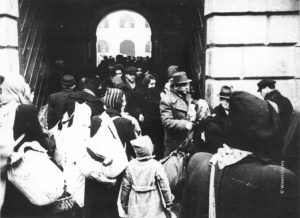Transit camps
In occupied Poland most Jews were forced into ghettos. In other parts of occupied Europe, Jews were marshalled into transit camps, ahead of their deportation to occupied Poland.

Arrival of Jewish families at Theresienstadt ghetto © Wiener Library
Theresienstadt (often referred to as Terezin) was set up as camp for Jews from Bohemia and Moravia. It then served as a transit camp for European Jews on their way to Auschwitz. Conditions were incredibly harsh. Over 50,000 Jews were gathered in a space previously inhabited by 7,000 Czechs. Terezin was publicised by the Nazis as a place of high culture – many artists, musicians and others from the arts were held there prior to deportation. But the camp served as a much more sinister propaganda exercise. Under pressure from the international community, the Nazis permitted the International Red Cross to visit the ‘transit camp’ in July 1944. An intensive period of deportations took place prior to the visit, and the camp was ‘beautified’ – gardens were planted, concerts were held and a propaganda film was created hailing the camp as a “model Jewish settlement”. The hoax worked and the International Red Cross were satisfied with the treatment of the prisoners. After the visit, deportations resumed.
The arrangements for transit of Jews, and the level of cooperation and collaboration from local non-Jewish populations, varied dramatically from country to country in German-occupied areas:
France
The Vichy Government helped organise the deportation of Jews – more than 70,000 people were deported through the Drancy transit camp in the outskirts of Paris. Most of the deported Jews were murdered in the east, however more than three-quarters of French Jews survived the German occupation.
Netherlands
Over 100,000 Jews were forcibly transported – most were processed through the Westerbork transit camp. Anne Frank, whose diary has raised awareness of the horrors of the Holocaust, was held in Westerbork after her family’s hiding place was betrayed to the Gestapo. However, 30,000 Dutch Jews survived, mostly by being successfully hidden by non-Jewish Dutch citizens. In 1941 portions of the population held strikes in protest at deportation of Jewish people – but this resistance could not be sustained and the majority of one of Europe’s most well-established Jewish populations were exterminated.
Belgium
The Belgian Jewish population mostly consisted of recent immigrants from Nazi Germany. Many of them quickly involved themselves in resistance activities, and fewer than half were deported to their deaths. Mechelen was the main camp through which Jews were deported – lying at a key railway junction between Brussels and Antwerp.
Italy
Fossoli di Carpi was the primary transit camp, and 6,800 of Italy’s 45,200 Jews were deported.
Greece
After German-occupation, Jews living in Thessaloniki (Salonica) – the centre of Sephardic Jewish life in Europe with over 50,000 Jewish citizens – were systematically moved to a ghetto by the railway station, from where they were deported.
Slovakia
The collaborationist wartime government eagerly participated in the deportation of its Jewish population, even paying the German regime a fee to remove Slovakian Jews. 80% of Jews in Slovakia were murdered. Sered served as a transit camp, sending thousands to death camps in occupied Poland.
Hungary
Despite its alliance with Nazi Germany and antisemitic laws, Hungary’s government resisted cooperating with the Nazis’ plans for the deportation of over 500,000 Hungarian Jews. Deportations didn’t begin until Germany invaded in March 1944. The German leadership ensured that Hungary’s Jews were rounded up and transported to camps in occupied Poland with ruthless efficiency – nearly 450,000 were forced onto trains, mostly to Auschwitz.


